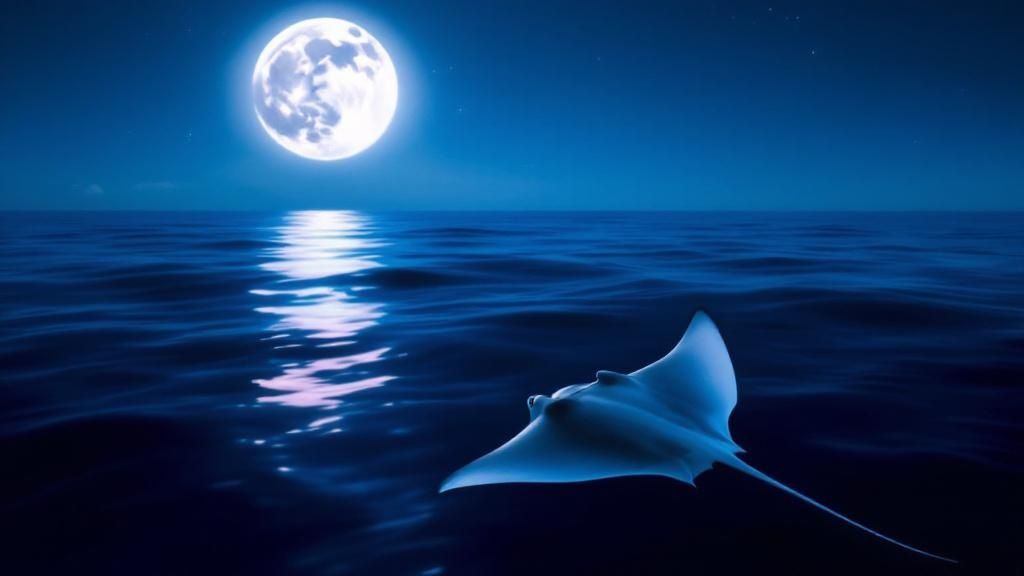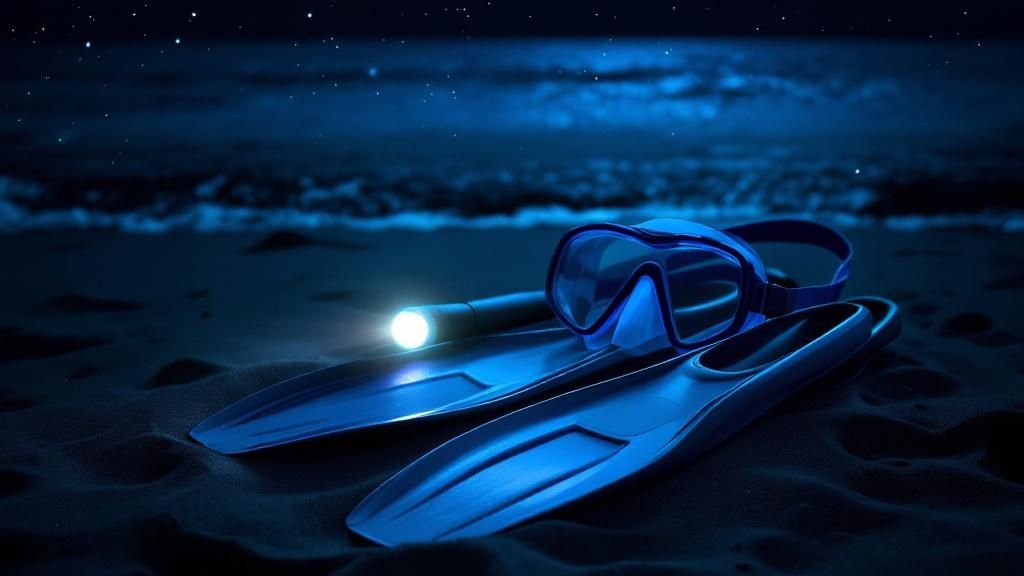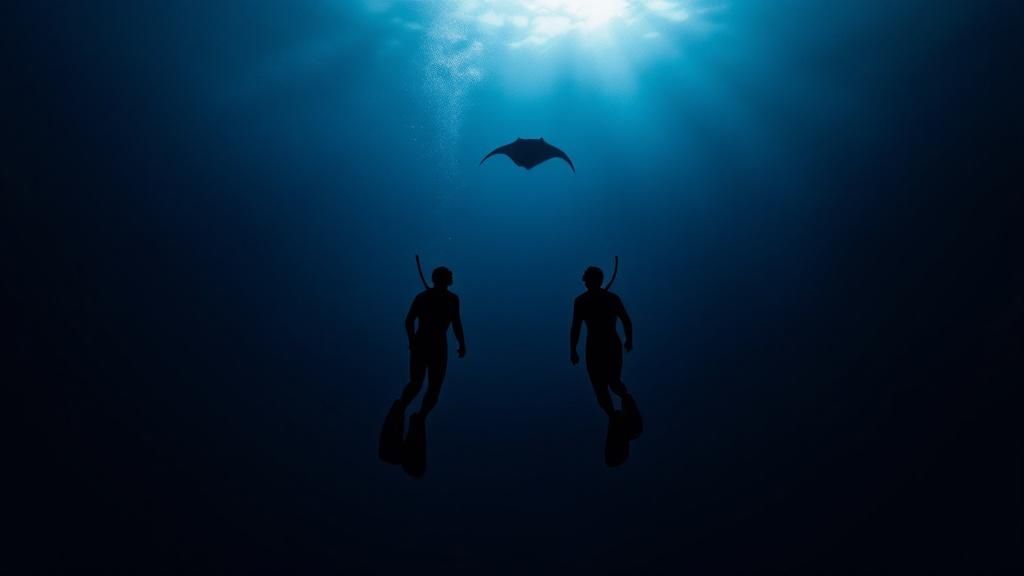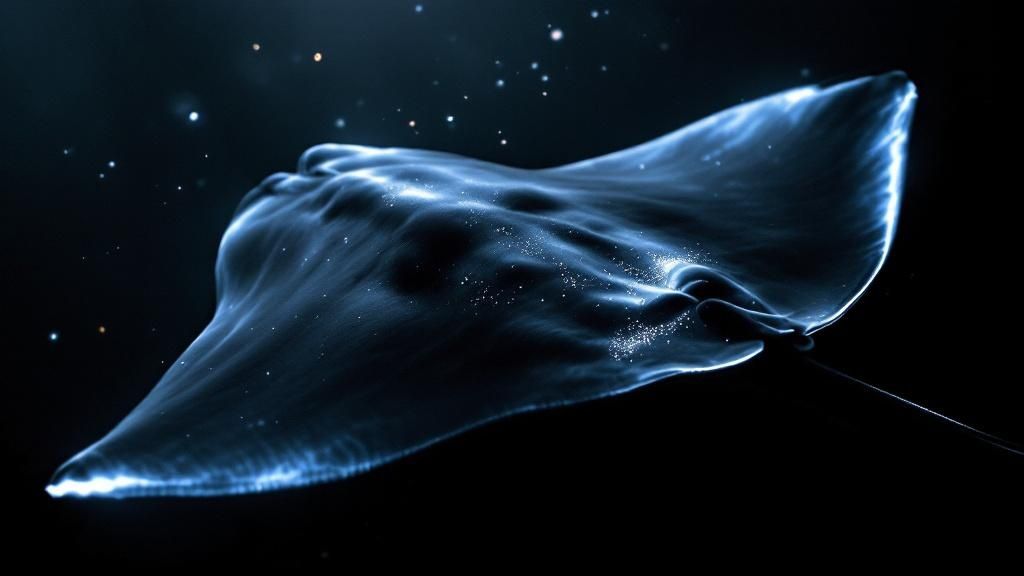Kona Manta Ray Night Snorkel Kona | Ultimate Guide & Tips

Picture this: you're floating weightlessly in the calm, dark Pacific Ocean. Below you, illuminated by underwater lights, majestic giants perform a silent, graceful ballet. They glide, swoop, and barrel roll right beneath your eyes. This isn't a dream—it's the magic of the manta ray night snorkel in Kona, and it's easily one of the most incredible wildlife encounters on the planet.
This guide is your complete playbook for an unforgettable adventure. We'll cover everything from the science behind the spectacle to picking the perfect tour.
Your Guide to Kona's Manta Ray Night Snorkel
There's a reason Kona is known as the best place on Earth for this experience, and we'll get into all the details. When you're ready to take the plunge, you'll want a world-class trip. That's where Kona Snorkel Trips comes in—they're the top-rated and most-reviewed snorkel company in all of Hawaii for a reason. These folks are the local experts, and they know how to create safe, mind-blowing manta encounters.
Ready for an adventure you'll be talking about for years? You can secure your spot on the premier Kona Manta Ray Snorkel Tour. If you're looking for an exceptional alternative, Manta Ray Night Snorkel Hawaii also runs outstanding tours and can be found at https://www.mantaraynightsnorkelhawaii.com/.

What Makes This Experience So Unique
The manta ray night snorkel in Kona isn't just another tour; it's a genuine phenomenon. It consistently gets ranked as one of the top marine encounters in the world, and for good reason.
Unlike so many wildlife tours where a sighting is left to chance, the manta viewing here is astonishingly reliable. Success rates often soar above 90%. You're almost guaranteed a show.
So, what's the secret? It's a perfect storm of natural biology and a little human ingenuity. Kona's volcanic coastline is the ideal habitat for plankton, which is the manta rays' favorite meal. Tour operators give nature a helping hand by submerging powerful, eco-friendly lights into the water.
These lights are like a dinner bell for plankton, drawing dense clouds of the microscopic critters to the snorkel sites. The mantas, smart creatures that they are, have learned that these lights mean an easy, all-you-can-eat buffet. It's created a predictable and truly awe-inspiring spectacle for us snorkelers.
This nightly feeding ritual lets you get an up-close view of these gentle giants as they gracefully barrel roll and glide through the illuminated water, their massive mouths wide open to filter plankton. It's a sight that's both mesmerizing and incredibly humbling.
Why Kona Is The Manta Ray Capital
You can find manta rays in tropical waters all over the globe, but nothing compares to Kona. What makes this spot so special is how accessible and consistent the encounters are. The local manta population doesn't migrate; they live right here along the Kona coast all year round. That means any time is a good time to book a tour.
Better yet, the main viewing sites are just a quick boat ride from shore, tucked away in calm, protected bays. This makes the whole adventure incredibly accessible for almost everyone, from families with kids to people who aren't the strongest swimmers.
To get a deeper dive into this unique ecosystem, check out our detailed guide on the Kona manta ray night snorkel. It's this one-of-a-kind combination of factors that has cemented Kona's reputation as the undisputed manta ray capital of the world.
So, How Does This Whole Manta Ray Thing Actually Work?
You might be wondering what makes the Kona manta ray night snorkel a world-famous, can't-miss experience. Is it just pure luck? Nope. It’s a brilliant bit of teamwork between Mother Nature and some clever human observation that’s created one of the most reliable wildlife encounters you can find anywhere on the planet.

It all starts with Kona’s unique underwater landscape. Thanks to ancient volcanic flows, our coastline has the perfect setup for all sorts of marine life to thrive. This environment is basically a five-star, all-you-can-eat buffet for zooplankton—the tiny microscopic critters that happen to be manta rays' favorite food.
This natural abundance sets the stage, but it's the tour operators who really get the party started.
The Ingenious "Dinner Bell" Effect
The real magic of the manta ray night snorkel Kona experience comes down to a simple, eco-friendly trick. Tour operators sink powerful (but totally safe) underwater lights into the ocean at a few specific spots.
Think of these lights as a giant dinner bell for the entire marine food chain.
These bright beams attract massive clouds of plankton, which are naturally drawn to light. The plankton swarm together in thick columns right under the lights, creating a concentrated feast that the mantas simply can't resist. Over the years, the local manta population has learned that these lights mean an easy, dependable meal, so they come back to the same spots almost every single night.
This learned behavior is what makes the sightings so consistent. It’s an incredible and awe-inspiring spectacle you can count on.
Gentle Giants of the Sea
The stars of the show, of course, are the reef manta rays (Mobula alfredi). These guys are majestic, known for their calm and gentle curiosity. And despite their massive size—we’re talking wingspans that can reach 12 feet—they are completely harmless to people.
Here’s why you have nothing to fear during this encounter:
- They're Filter Feeders: Manta rays eat by gliding through the water with their huge mouths open, filtering out tiny plankton. They don't have teeth for biting or chewing.
- No Stingers: Unlike their stingray cousins, manta rays do not have a stinger or barb on their tails. They are totally defenseless.
- A Passive Nature: They are chill, curious creatures that are only there for the plankton. The whole experience is about passively watching them do their thing without any interference.
This amazing balance of accessibility and conservation has turned Kona into the world capital for this kind of marine adventure. The nightly tours draw around 80,000 people annually, which tells you just how popular and reliable it is. The sighting success rate is insanely high, hovering between 85% and over 95%. On any given night, you can expect to see an incredible underwater ballet featuring anywhere from 5 to 20 mantas. If you want to dive deeper, check out the fascinating statistics behind Kona's manta ray dives.
Once you get the science behind it, you appreciate the whole experience on a much deeper level. It’s a perfect harmony between a one-of-a-kind ecosystem and responsible tourism, creating an unforgettable encounter that respects both the animals and their home.
Choosing The Best Manta Ray Snorkel Site in Kona
When you start planning your manta ray night snorkel in Kona, you'll quickly realize that not all spots are created equal. The Big Island is lucky to have a couple of key locations where these gentle giants gather for their nightly plankton feast, but the two most popular sites offer very different experiences. Knowing what sets them apart is the key to picking the adventure that’s right for you.

The two main players are affectionately known as "Manta Village" and "Manta Heaven." Think of them as having their own distinct personalities. Your decision will likely boil down to what you’re most comfortable with versus how many mantas you’re hoping to see.
Manta Village: The Calm And Consistent Choice
Just off the coast of the Sheraton Keauhou Bay Resort, Manta Village is the original manta ray snorkel site, and it’s been a reliable favorite for years. Tucked inside Keauhou Bay, it’s naturally shielded from the open ocean swells, which means the water here is almost always calmer and more protected.
This makes it a fantastic option for a few types of snorkelers:
- Families with younger kids who might feel more at ease in gentle waters.
- First-timers or nervous snorkelers looking for a less intimidating way to experience the ocean at night.
- Anyone prone to seasickness, since the boat ride is usually shorter and the conditions are much smoother.
You might see slightly fewer mantas here compared to its northern cousin—typically 5 to 10 on any given night—but the real draw is its consistency. The bay is a dependable feeding ground, and the calmer vibe makes for a wonderfully serene and peaceful experience. To learn more about what makes these sites tick, check out our deep dive into the science of the manta ray night snorkel.
Manta Heaven: The Action-Packed Arena
A bit further north, near the Kona International Airport, you’ll find Manta Heaven (also called Garden Eel Cove). This spot definitely lives up to its name, often attracting a much larger gathering of rays—it’s not uncommon to see 10 to 20 mantas in one night! The show here can be absolutely breathtaking, with more animals creating a dynamic, action-packed underwater ballet.
The catch? This location is more exposed to the open ocean. That means the water can be choppier and the currents can be stronger, which can be a bit more of a challenge. It's generally a better fit for more confident, experienced snorkelers who are comfortable with variable conditions. The boat ride to get there is also a little longer.
Kona Manta Ray Snorkel Sites Compared
So, how do you choose? Here’s a quick side-by-side to help you figure out which site is the best fit for your adventure.
| Feature | Manta Village (Keauhou Bay) | Manta Heaven (Garden Eel Cove) |
|---|---|---|
| Location | South of Kona, near Sheraton | North of Kona, near the Airport |
| Water Conditions | Calm & Protected | Choppier, Open Ocean |
| Best For | Families, beginners, nervous snorkelers | Confident, experienced snorkelers |
| Average Sighting | 5 to 10 mantas | 10 to 20 mantas |
| Atmosphere | Serene & consistent | Action-packed & dynamic |
| Boat Ride | Shorter | Longer |
At the end of the day, there's no "wrong" choice, just the one that’s better suited for you. Manta Village offers a calmer, more predictable setting, while Manta Heaven delivers a potentially more spectacular show with more rays, but in more challenging waters.
The manta ray night snorkel is truly a cornerstone of Hawaii's marine tourism, bringing in around 80,000 visitors each year and supporting countless local businesses. The industry is built on an incredible 80% to 95% success rate for sightings, depending on the night. This reliability, especially from June to August when the water is clearest, is what makes this a can't-miss Kona experience.
What to Expect on Your Manta Ray Snorkel Tour
So, you’re ready for the adventure of a lifetime. Let's walk through exactly how the evening unfolds on a manta ray night snorkel in Kona. Knowing the play-by-play helps ease any of those pre-trip jitters and turns them into pure, confident excitement. The whole experience is dialed in to be smooth, safe, and completely unforgettable.

Your journey kicks off in the late afternoon when you check in at the harbor. The sun will just be starting to dip, painting the Kona coastline in stunning shades of gold and orange—the perfect opening act for the main event. This is your chance to meet the crew, sign any waivers, and get familiar with the boat that’ll be your ride for the evening.
The Scenic Boat Ride and Briefing
Once everyone's on board, you'll head out on a beautiful boat ride along the coast. While you're enjoying the views, the crew will run through a detailed safety briefing. They'll cover everything from getting your snorkel gear just right to what to do once you're in the water. This is also when they'll share some incredible facts about Kona’s resident manta rays, their habits, and why it's so important to be a passive observer.
This briefing is super important for a couple of reasons:
- Your Safety: It makes sure everyone is on the same page and feels totally comfortable and secure from start to finish.
- The Mantas' Safety: You'll learn the golden rule of manta encounters: look, but don't touch. This protects the delicate mucous coating on their skin, which is vital for their health.
Pay close attention to your guides. Their experience is the key to having a responsible and mind-blowing time. They’ve spent thousands of hours with these amazing animals and know exactly how to create a safe space for both people and mantas.
Gearing Up and Getting in the Water
As the boat anchors at the snorkel site, the sky will have deepened from sunset pastels to a rich twilight blue. Time to get ready! The crew will help you get fitted with your gear, which usually includes a wetsuit, a quality mask, and a snorkel. That wetsuit is a game-changer; it gives you a little extra buoyancy and keeps you warm and comfy in the ocean after the sun has checked out.
Then comes the moment you've been waiting for. You’ll slide into the dark, calm water and swim over to a custom-built light board. These are essentially big, stable floating rafts with powerful lights pointing down into the depths. All you have to do is hold onto the handles, float on the surface with your face in the water, and watch the brightly lit circle below you.
Think of the light board as your front-row seat at an underwater theater. It keeps you floating effortlessly and in the perfect spot, so you can just relax, breathe through your snorkel, and wait for the show to begin.
The Underwater Ballet Begins
Those powerful lights are there for a reason: they attract swarms of microscopic plankton, which happens to be the manta rays' favorite meal. It might take a few minutes, but then the magic starts. The first massive, dark silhouette will glide gracefully out of the blackness and into the light.
With its mouth wide open, the manta ray begins a beautiful, looping dance. It will swoop and barrel roll right underneath you, sometimes just inches away, as it filters the plankton from the water. Before you know it, more mantas arrive, creating a silent, mesmerizing ballet. There’s truly nothing like watching these gentle giants, with wingspans reaching up to 12 feet, perform their nightly feeding ritual.
You’ll spend about 30 to 45 minutes in the water, completely captivated, before heading back to the boat for a warm ride to the harbor under a sky full of stars.
Getting Ready for Your Night Snorkel Adventure
A little bit of prep can make the difference between a good night and an unforgettable one. Knowing what to bring—and what you can leave behind—for your manta ray night snorkel in Kona means you'll be comfortable, relaxed, and ready to soak it all in. The idea is to show up without a worry in the world, so your only focus is on the gentle giants gliding below you.
The single most important tip? Arrive ready to get wet. Wear your swimsuit under your clothes. This makes the whole process of getting geared up on the boat quick and painless, saving you from trying to change in a tiny marine bathroom.
What to Pack vs. What We Provide
One of the best parts of going out with a professional tour is that all the heavy lifting—and heavy gear—is handled for you. You don't need to stress about lugging around your own snorkel equipment. We've got you covered with everything you need for a safe and comfortable swim.
Here's what you can expect from us:
- High-Quality Snorkel Gear: We provide professionally sanitized masks, snorkels, and fins that are properly fitted for you.
- Wetsuits: The Pacific can get a little chilly after the sun goes down. A good wetsuit keeps you warm and buoyant, letting you relax completely.
- Flotation Support: You'll be holding onto a custom-made, high-powered light board. This board is your stable base in the water, providing all the flotation you'll need without any effort.
So, what should you actually bring? It's all about comfort before and after your time in the water. Think warm and cozy for the boat ride back to the harbor under the stars.
Your job is to show up ready for an amazing time. Let the tour company handle the technical stuff. Just pack a few personal items to make your evening as comfortable as possible.
Your Manta Ray Snorkel Packing Checklist
We've put together a simple checklist to make sure you have everything you need for a fantastic night snorkel. This little bit of planning goes a long way.
| What to Bring | What Your Tour Provides |
|---|---|
| Swimsuit (worn under your clothes) | High-quality mask and snorkel |
| Towel for drying off after the snorkel | Properly fitted fins |
| Dry change of clothes or a warm jacket | Buoyant and warm wetsuit |
| Reusable water bottle to stay hydrated | Custom light board for flotation |
| Underwater camera (like a GoPro) | Professional safety briefing and guides |
| Motion sickness medication (if needed) | Snacks and refreshments (usually) |
Trust me, having a warm jacket and a fluffy towel waiting for you when you get out of the water is a total game-changer. It makes the ride back to shore feel absolutely blissful.
The reason Kona is such a world-class spot for this adventure is the sheer consistency of the sightings. We have an estimated resident population of over 450 individual manta rays, which means your chances of having a magical encounter are incredibly high. Most tours here boast a sighting success rate of 85-95%. You’ll spend about 45 to 60 minutes in the water, watching these incredible animals feed in the plankton-rich shallows. For a deeper dive, check out more insights on the amazing Kona manta ray population and sighting statistics.
How to Be a Good Guest: Safety and Responsible Viewing
Being in the water with these gentle giants is an absolute privilege, and it comes with a shared responsibility to protect them. The whole experience is built on a foundation of respect. Think of it like being an invited guest in their underwater dining room—you're there to watch the magic, not to interfere with dinner.
This core idea is called passive observation, and it's the golden rule for every reputable tour out there. By following a few simple but crucial guidelines, you become a partner in conservation, helping make sure this incredible natural wonder continues for generations. Your tour operator's top priority will always be your safety and the well-being of the mantas.
The Golden Rule: No Touching
If you remember only one thing, make it this: look, but do not touch the manta rays. It’s not just about being polite; it’s essential for their health. Manta rays have a delicate, protective mucous coating covering their skin. This slimy layer is basically their immune system, shielding them from nasty bacteria and infections.
When someone touches a manta, even by accident, it can rub off this crucial protective film. This leaves them exposed and vulnerable to disease. Simply resisting that urge to reach out and "pet" them is the single most important thing you can do to keep them safe.
"Observe only: No touching. Resist the urge to ‘pet’ the mantas. This will rub off their protective mucus coating. Do not chase, grab, or try to take a ride on the mantas. This doesn’t benefit the animal in anyway." – PADI Project AWARE Guideline
By keeping a respectful distance and your hands to yourself, you're actively helping to conserve Kona's beloved manta ray population. It’s that simple.
Follow Your Guide's Lead
Your guides are the key to a great night. They’ve spent countless hours in the water with these animals and know their behavior inside and out. Listening closely to their instructions, both during the safety briefing and once you're in the water, is non-negotiable. It's for your safety and for the mantas' comfort.
Here are the main things they'll ask you to do:
- Hold onto the light board: This is your home base. It's a stable, floating platform that keeps you safely at the surface and gives you the best seat in the house.
- Don't dive down: Snorkelers stay on the surface, period. Diving down can get in the way of the mantas' feeding paths, which can stress them out and make them leave. Let the divers handle the bottom, we'll handle the top.
- Keep splashing to a minimum: Try to float calmly and move slowly. Thrashing around or kicking wildly can startle the mantas. A peaceful environment is what allows them to feel comfortable and feed naturally.
- Point lights down: If you have any lights, your guides will tell you to shine them straight down from the surface. This concentrates the plankton in one area for the mantas, creating the "buffet line."
Following these rules helps create a calm, predictable environment where the mantas feel secure. And when they feel secure, they stick around, giving everyone a much closer and more magical experience. You get to witness their beautiful underwater ballet completely undisturbed. This is why choosing a responsible tour operator who enforces these guidelines is so important—it safeguards the whole ecosystem.
Frequently Asked Questions About the Manta Ray Snorkel
It’s totally normal to have a few questions before you jump into the water for a manta ray night snorkel in Kona. We get it. Feeling confident and prepared is the best way to make sure you can relax and just soak in every amazing moment.
We’ve put together the answers to the questions we hear most often to help you get ready for the adventure.
Do I Need To Be a Strong Swimmer for This Tour?
This is probably the number one question we get, and the answer is a relief for many: no, you definitely don't need to be an expert swimmer. Tour operators have this experience dialed in to make it safe and accessible for just about everyone.
You'll be holding onto a big, custom-made light board that floats on the surface. It's incredibly stable and buoyant. This board does all the work for you, so you can just hang on and float without any effort. Plus, the wetsuit you'll be wearing adds even more buoyancy.
As long as you're comfortable putting your face in the water and breathing through a snorkel, you're good to go.
Is It Guaranteed That We Will See Manta Rays?
While mantas are wild animals and nobody can ever make a 100% guarantee, the success rate here on the Kona coast is exceptionally high—we're talking over 90% on most nights. The snorkel sites are well-established feeding grounds, and the powerful lights create a reliable buffet that the mantas rarely miss.
That said, in the rare case the mantas decide to be shy, almost all reputable tour companies offer a "manta guarantee." This usually means you can come back another night for free. It’s always a smart move to book your snorkel for earlier in your vacation, just in case you need to use that second chance.
What Is the Best Time of Year for a Manta Ray Snorkel?
Here’s the fantastic news: the manta ray snorkel in Kona is an incredible, year-round adventure. Our local manta population doesn't migrate; they live here along the coast all year long, so there’s never really an "off-season."
Weather-wise, conditions are generally great throughout the year. If you're looking for the absolute calmest ocean and clearest water, the summer months often deliver, which can make a spectacular experience even better. But honestly, no matter when you visit, your chances of an unforgettable encounter are excellent.
Are the Manta Rays Dangerous?
Not in the slightest. Manta rays are known as "gentle giants," and they've earned that nickname. They are completely harmless to people.
Manta rays are filter feeders, which means their diet consists of tiny, microscopic plankton. They don't have teeth for biting, and unlike their stingray cousins, they have no stinger or barb on their tail.
The golden rule on this snorkel is to be a passive observer—look, but don't touch. This isn't for your safety, but for theirs. Touching can harm the delicate protective coating on their skin.
For even more answers, you can dive into our complete list of frequently asked questions about manta rays.
Ready to witness this incredible underwater ballet for yourself? Kona Snorkel Trips offers the highest-rated and most-reviewed manta ray night snorkel on the Big Island, ensuring a safe, respectful, and absolutely unforgettable adventure. Book your tour today
